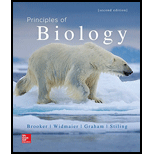
Principles of Biology
2nd Edition
ISBN: 9781260081848
Author: Robert Brooker
Publisher: Mcgraw-hill Higher Education (us)
expand_more
expand_more
format_list_bulleted
Concept explainers
Question
Chapter 44, Problem 2CCQ
Summary Introduction
To write:
Feeding Trophic level of Carrion Beetle.
Introduction:
Carrion Beetle is commonly known as beetle. Carrion means the dead body of an animal, hence, the beetle is named as ‘carrion beetle’ because they feed on the bodies of a dead animal. It belongs to Animalia (Kingdom), Arthropoda (Phylum), Insecta (Class), Coleoptera (Order), Staphylinoidea (Superfamily), Silphidae (Family). They feed on bodies of dead animals. Some species of carrion beetle feed on plants for food, or rarely, they hunt caterpillars or snails. The distribution of carrion beetle is worldwide. They come in various sizes.
Expert Solution & Answer
Want to see the full answer?
Check out a sample textbook solution
Students have asked these similar questions
What is behavioral adapt
22. Which of the following mutant proteins is expected to have a dominant negative effect when over-
expressed in normal cells?
a. mutant PI3-kinase that lacks the SH2 domain but retains the kinase function
b. mutant Grb2 protein that cannot bind to RTK
c. mutant RTK that lacks the extracellular domain
d. mutant PDK that has the PH domain but lost the kinase function
e. all of the above
What is the label ?
Chapter 44 Solutions
Principles of Biology
Ch. 44.1 - Prob. 1CCCh. 44.1 - Prob. 1TYKCh. 44.1 - Lake Baikal in Siberia is an ancient, unglaciated...Ch. 44.1 - Prob. 3TYKCh. 44.2 - Prob. 1TYKCh. 44.2 - Prob. 2TYKCh. 44.3 - Why might ecologists think of walking thecoastline...Ch. 44.3 - Prob. 2CCCh. 44.3 - Which of the following are examples of secondary...Ch. 44.3 - In New England salt marshes, Spartina grass...
Ch. 44.3 - Prob. 3TYKCh. 44.4 - Prob. 1CCCh. 44.4 - Prob. 1BCCh. 44.4 - Prob. 2CCCh. 44.4 - Which is part of the original MacArthur-Wilson...Ch. 44.4 - Prob. 2TYKCh. 44.5 - In these two food chains, plants and...Ch. 44.5 - Prob. 1CCCh. 44.5 - Prob. 1TYKCh. 44.5 - Detritivores that feed on the dung of herbivores...Ch. 44.5 - Prob. 3TYKCh. 44.6 - Net primary production is the energy that passes...Ch. 44.6 - Prob. 2TYKCh. 44.6 - Most gross primary production is used in (by)...Ch. 44 - Prob. 1TYCh. 44 - Prob. 2TYCh. 44 - Prob. 3TYCh. 44 - Prob. 4TYCh. 44 - On which types of islands would you expect species...Ch. 44 - Prob. 6TYCh. 44 - Autotrophic organisms are primary consumers....Ch. 44 - Prob. 8TYCh. 44 - Prob. 9TYCh. 44 - The most highly productive terrestrial ecosystems...Ch. 44 - Prob. 1CCQCh. 44 - Prob. 2CCQCh. 44 - Prob. 3CCQCh. 44 - List some possible ecological disturbances, their...Ch. 44 - Prob. 2CBQ
Knowledge Booster
Learn more about
Need a deep-dive on the concept behind this application? Look no further. Learn more about this topic, biology and related others by exploring similar questions and additional content below.Similar questions
- Can you described the image? Can you explain the question as well their answer and how to get to an answer to an problem like this?arrow_forwardglg 112 mid unit assignment Identifying melting processesarrow_forwardGive only the mode of inheritance consistent with all three pedigrees and only two reasons that support this, nothing more, (it shouldn't take too long)arrow_forward
- Oarrow_forwardDescribe the principle of homeostasis.arrow_forwardExplain how the hormones of the glands listed below travel around the body to target organs and tissues : Pituitary gland Hypothalamus Thyroid Parathyroid Adrenal Pineal Pancreas(islets of langerhans) Gonads (testes and ovaries) Placentaarrow_forward
- What are the functions of the hormones produced in the glands listed below: Pituitary gland Hypothalamus Thyroid Parathyroid Adrenal Pineal Pancreas(islets of langerhans) Gonads (testes and ovaries) Placentaarrow_forwardDescribe the hormones produced in the glands listed below: Pituitary gland Hypothalamus Thyroid Parathyroid Adrenal Pineal Pancreas(islets of langerhans) Gonads (testes and ovaries) Placentaarrow_forwardPlease help me calculate drug dosage from the following information: Patient weight: 35 pounds, so 15.9 kilograms (got this by dividing 35 pounds by 2.2 kilograms) Drug dose: 0.05mg/kg Drug concentration: 2mg/mLarrow_forward
- A 25-year-old woman presents to the emergency department with a 2-day history of fever, chills, severe headache, and confusion. She recently returned from a trip to sub-Saharan Africa, where she did not take malaria prophylaxis. On examination, she is febrile (39.8°C/103.6°F) and hypotensive. Laboratory studies reveal hemoglobin of 8.0 g/dL, platelet count of 50,000/μL, and evidence of hemoglobinuria. A peripheral blood smear shows ring forms and banana-shaped gametocytes. Which of the following Plasmodium species is most likely responsible for her severe symptoms? A. Plasmodium vivax B. Plasmodium ovale C. Plasmodium malariae D. Plasmodium falciparumarrow_forwardStandard Concentration (caffeine) mg/L Absorbance Reading 10 0.322 20 0.697 40 1.535 60 2.520 80 3.100arrow_forwardPlease draw in the missing answer, thank youarrow_forward
arrow_back_ios
SEE MORE QUESTIONS
arrow_forward_ios
Recommended textbooks for you
 Human Biology (MindTap Course List)BiologyISBN:9781305112100Author:Cecie Starr, Beverly McMillanPublisher:Cengage Learning
Human Biology (MindTap Course List)BiologyISBN:9781305112100Author:Cecie Starr, Beverly McMillanPublisher:Cengage Learning Biology: The Dynamic Science (MindTap Course List)BiologyISBN:9781305389892Author:Peter J. Russell, Paul E. Hertz, Beverly McMillanPublisher:Cengage Learning
Biology: The Dynamic Science (MindTap Course List)BiologyISBN:9781305389892Author:Peter J. Russell, Paul E. Hertz, Beverly McMillanPublisher:Cengage Learning
 Biology (MindTap Course List)BiologyISBN:9781337392938Author:Eldra Solomon, Charles Martin, Diana W. Martin, Linda R. BergPublisher:Cengage Learning
Biology (MindTap Course List)BiologyISBN:9781337392938Author:Eldra Solomon, Charles Martin, Diana W. Martin, Linda R. BergPublisher:Cengage Learning


Human Biology (MindTap Course List)
Biology
ISBN:9781305112100
Author:Cecie Starr, Beverly McMillan
Publisher:Cengage Learning

Biology: The Dynamic Science (MindTap Course List)
Biology
ISBN:9781305389892
Author:Peter J. Russell, Paul E. Hertz, Beverly McMillan
Publisher:Cengage Learning


Biology (MindTap Course List)
Biology
ISBN:9781337392938
Author:Eldra Solomon, Charles Martin, Diana W. Martin, Linda R. Berg
Publisher:Cengage Learning
